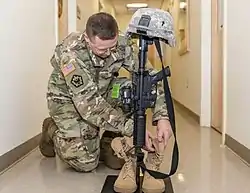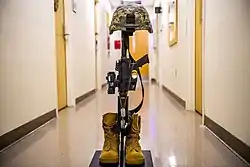Battlefield cross
The Fallen Soldier Battle Cross, Battlefield Cross or Battle Cross is a symbolic replacement of a cross, or marker appropriate to an individual service-member's religion, on the battlefield or at the base camp for a soldier who has been killed. It is made up of the soldier's rifle stuck into the ground or into the soldier's boots, with helmet on top. Dog tags are sometimes placed on the rifle, and the boots of the dead soldier can be placed next to the rifle. The purpose is to show honor and respect for the dead at the battle site. The practice started during or prior to the American Civil War, as a means of identifying the bodies on the battleground before removal. Today, it is a means of showing respect for the dead amongst the still living members of the troop. It is commonly seen in the field or base camp after a battle, especially among American troops in Afghanistan or Iraq. While it is used less today as a means of identification, it still serves as a method of mourning among the living, as attending the funeral is not always possible for soldiers still in combat.

United States Army


This ceremony is described in US Army Field Manual (FM) No. 7-21.13, entitled "The Soldiers Guide", Appendix C "Ceremonies", Section III "Memorial Ceremony"[3], excerpted as follows:
SECTION III - MEMORIAL CEREMONY
C-4. Memorial ceremonies are patriotic tributes to deceased soldiers. These ceremonies are command-oriented so attendance is often mandatory. The ceremony is a military function that is not normally conducted in a chapel. The content of the ceremony may vary depending on the desires of the commander.
C-5. In most cases, the unit prepares a program that may include a biographical summary of the deceased soldier with mention of awards and decorations. The following elements are commonly part of a memorial ceremony:
- Prelude (often suitable music).
- Posting of the Colors.
- National Anthem.
- Invocation.
- Memorial Tribute (e.g., remarks by unit commander or a friend of the deceased).
- Scripture Reading.
- Hymn or other special music.
- Meditation (quiet moment for attendees to reflect).
- Benediction.
- Last Roll Call. This is a final tribute paid by soldiers to their dead comrade. It has its origin in the accountability roll call conducted by the unit First Sergeant following combat. Although sometimes painful to listen through, the Last Roll is called with the conviction held by soldiers that all unit members will be accounted for, and none will ever be forgotten.
- Firing of rifle volleys.
- Taps.
C-6. Most units prepare a visible reminder of the deceased soldier similar to that depicted in Figure C-1. The helmet and identification tags signify the dead soldier. The inverted rifle with bayonet signals a time for prayer, a break in the action to pay tribute to our comrade. The combat boots represent the final march of the last battle. The beret (in the case of soldiers from airborne units) reminds us that the soldier has taken part in his final jump.
In Sculpture
Fresno, California
- There is a bronze sculpture of the Battlefield Cross at the Veterans of Foreign Wars (VFW) Post 8900, 3585 N. Blythe Ave., Fresno, California. The artist who created it is also a veteran. The plaque at the base reads: "The Fallen Veteran Memorial."
- There is a Battlefield Cross Memorial at La Sierra Military Academy.[4]
See also
References
- "Team Natick takes a stand against grief". www.army.mil. Retrieved 2019-05-09.
- CCDC Soldier Center, Natick Mass. (26 April 2019) Team Natick takes a stand against grief
- The Soldiers Guide", Appendix C "Ceremonies", Section III "Memorial Ceremony"
- http://abc30.com/amp/society/battlefield-cross-memorial-unveiled-at-la-sierra-military-academy/2246690/
External links
![]() Media related to Soldier's Cross at Wikimedia Commons
Media related to Soldier's Cross at Wikimedia Commons